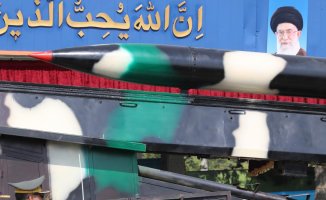"We fight for the survival of the memory of our community", this is how the AKA explained it to La Vanguardia, rapper and founding member of Agroarte, a project born in Comuna 13 of Medellín (Colombia). The objective of this initiative is to weave a strong community, occupying "spaces of fear", through planting and rap. Currently, thanks to Agroarte, the urban part of San Javier (the Comuna 13 neighborhood) has significantly improved its quality of life and its protection from drug cartels. This situation has been achieved thanks to the creation of nine community projects that combine the creative abilities of people with the recovery of the memory of the territory.
It all started with the urban war that devastated Comuna 13 between 2001 and 2003. The paramilitaries of the United Self-Defense Forces of Colombia (AUC), the national police and army organized themselves to "clean" the neighborhood of drug traffickers. The urban guerrillas of the Revolutionary Armed Forces of Colombia - People's Army (FARC-EP), the National Liberation Army and the People's Armed Commands were unable to face the state offensive. For two years, random homicides and arrests were carried out, and the great shadow of the war was installed on the outskirts of the city: the Escombrera, the largest mass grave in Antioquia.
La Escombrera was gaining ground on the border between the urban part and the rural part of San Javier. According to Agroarte, "people detained, tortured, executed and buried" were clandestinely buried there. That was how in 2002, the inhabitants of the countryside began to organize themselves and "thanks to the planting, we began to resist the Escombrera", recalls the AKA.
Although peasant families resisted for a long time on the urban-rural border, state threats began to materialize. "Many of us were followed, they exerted pressure on our families, they even shot us in our homes... So we were forced to leave our homes," explains the rapper. Then the exodus to the urban part of Comuna 13 took place.
It was in the streets and squares that those who resisted the Escombrera met with the residents of San Javier. With the new community alliances, they began to occupy the spaces that were previously dominated by cartels and armed actors. The weapons of the people: the garden, rap and mural painting.
This is how the Hip Hop Agrarian project was conceived, thanks to which more than three hundred young people have been able to compose their first songs and have learned to articulate their own speeches. In addition, the rapprochement between the doñas (mothers) and their children is also encouraged. "The garden attracts the adult generation and hip hop attracts the young. But in the end, everyone ends up participating in everything," explains the AKA. In this way, the process of generational renewal in Agroarte is encouraged.
The intergenerational bond is also cultivated with the Seeds of the Future project, with which the commitment to the neighborhood is worked on so that the youngest learn to lead new community processes as they get older.
In addition to its clear local vocation, Agroarte crosses borders to bring its projects closer to other communities. This is how, on October 28, the AKA and the video artist Katerin D Franco starred in the presentation of the web series From the other shore of memory, at the Espai Associatiu Lola Anglada in Barcelona.
"Memory is an organic process by which community organization in neighborhoods is justified," explains the creator of the series, Katerin D Franco. In this way, she conceived the documentary project, in which unknown people maintain an anonymous handwritten correspondence in which they share their memories and experiences. Until the third letter they do not reveal their identity and the surprise is that many of them would never have spoken or shared anything if they had known who they were from the beginning.
The series has five chapters and each one focuses on a theme: development, academia, exile, trades and war. Each pair of correspondences represents opposite positions within the matter in question but, nevertheless, thanks to the exercise of sharing a collective memory, politically highly polarized people can be humanized. "Some have gotten to know each other in person or have kept up the correspondence once the series ended," adds the creator.
The rapper values the work of his partner and emphasizes that in Colombia, internal violence has greatly polarized the population: "The politics of war wants to confront people so that we kill each other. We have had so much resentment for so long that we have very few spaces where we can recognize ourselves humanly".
Although Agroarte has never ceased to be in conflict with the Colombian state, now tourism is the new open front that threatens the spaces that have been recovered by the people of Comuna 13. "There are several memory sites [of the war] that we we want to recover or that we have already recovered, but there is no Colombian law that helps us protect them, or that recognizes them as patrimonial", explains the rapper.
After the Peace Agreements with the FARC (2016), the Colombian government created two offices to try to respond to war crimes: the Special Jurisdiction for Peace (JEP), which is responsible for judging and punishing war crimes ; and the Truth Commission, which oversees the clarification of the facts. To this last official, Agroarte presented a report in order to protect its spaces of remembrance and mourning.
"In Colombia, an official and institutional version of the acts of war is known, but it is not the same version as that of the people who inhabit the territory. For this reason, for the people of Comuna 13 it is of vital importance to protect and maintain these places of remembrance", emphasizes the AKA.
With the manipulation of the official discourse, the image of the "miracle of Medellín" has been sold to encourage tourism, which is concentrated in four neighborhoods of San Javier. "Currently, one hundred thousand tourists a month arrive at Comuna 13," continues the rapper. "The paramilitary government, which is the one that controls the territory in practice, sells the transformation of the city by hiding historical acts of war such as La Escombrera." Thus, Agroarte prioritizes in all its initiatives to recover and maintain the historical, cultural, social and political memory of the territory. "In this way, the following generations will know that before the 2002 war there was already a community organization in Medellin, because from the beginning we have been self-constructed neighborhoods," concludes the Colombian.
In addition, according to Agroarte, because of tourism, child prostitution has increased, extortion by armed actors against tourist guides and the artistic activism of the people of the territory is being trivialized. "Many of the murals that are painted now have no cause or reflection, unlike the first ones we started doing in Comuna 13," adds the rapper.
However, neither the AKA nor the Agroarte project lose hope and continue to fight to make their history visible and weave a strong community in the territory. "We tell our story and, at the same time, we confront the State. That is why we make the songs, that is why we sow and that is why we raise the stories, so that memory returns and hopefully it will never be erased from the territory," the rapper concludes.













